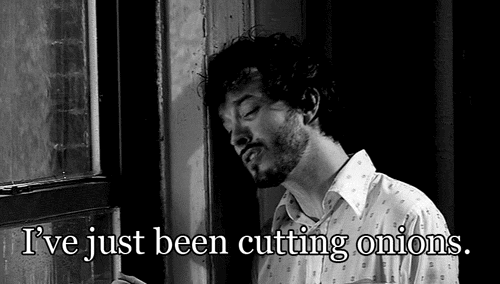I wanted to begin today by saying thank you. Thank you to Jon Stewart and The Daily Show for 16 kick-ass years.
Every morning, for I don’t know how long, my ritual has been…
1. Get-up.
2. Pee.
3. Make breakfast.
4. Watch The Daily Show while eating breakfast.
And that’s how I roll.
This morning, however, was the last time I’d be eating my 5-egg omelet[footnote]Whole eggs, none of this lame ass egg white nonsense.[/footnote] while watching and listening to Stewart’s commentary on everything from shady politicians and government BS to his pining about the New York Mets[footnote]Although, as I type these words they’re in 1st place.[/footnote] and the travesty, that is, eating a slice of pizza with a fork.
Not coincidentally, I suspect, this morning was also the last morning I’d end up with pieces of egg on my computer screen from laughing so hard.
Okay, deep breaths…I shouldn’t be so cynical. I’m sure Trevor Noah is going to do a fantastic job taking over for Stewart on the show. I’m still going to get up, make breakfast, and watch. But it’s going to take a while to get used to not having Stewart on screen to serve as the voice of reason, bringing to light some of the WTFness of the world, and making us laugh all the same.
Wait, what was that? No, of course not. I’m not crying! Are you kidding me? It just so happens, you know, Lisa’s in the kitchen cutting a bunch of onions. Yeah that’s it. No crying here.

Thanks again Jon.
Sounding Off – Christa Vancini Doran

I LOVED this article by Christa – owner of Tuff Girl Fitness in Hamden, CT. Christa is one of my “go to” ambassadors for women’s fitness and someone who, not only I respect a ton, but someone who unabashedly doesn’t back down from fighting many of the mainstream stigmas and myths plaguing women in fitness today. One deadlift, squat, chin-up, kettlebell swing, and push-up at a time.
Musings of a Disturbed Strength Coach – Film Fest Edition – Lee Boyce
Anyone who knows me well knows I love movies. Or, to play more of the uppity movie snob role, I love film.
I’m just as likely to head to the independent theater down the street from my apartment to watch a subtitled Italian film about a dude who makes a bowl of rigatoni for a chick he likes as I am to head to the movieplex to watch explosions, zombies, ninjas, hobbits, and exploding zombies fighting ninjas and hobbits.
Lee’s a good friend, phenomenal coach, and just as obsessed with movies as I am. We’ll often text each our reviews of recent movie we watched.
This post was a very witty and impressive feat of wordplay by Lee.
75+ movie references with a (fitness) message to boot. Give it a read.
Advanced Core Training – Dean Somerset
There’s only a few more days to take advantage of the sale price for Dean’s latest resource. He did an amazing job with it – as always – and I feel it would be a valuable addition to any trainer or coach looking to upgrade their knowledge base on “core” anatomy, assessment, and building exercise progression/regression algorithms.
Here’s a small clip:
Full Disclosure/Rant Ahead: Dean is a good friend, he was in my wedding, we’ve shared what was seemingly a 10×10 square foot room in the middle of London for four days, but still managed to avoid spooning each other.[footnote] Or did we?[/footnote]
I can understand why some people would be suspect I’d promote his product. Affiliate circle jerking is what it’s often affectionately called on the internet. So cute!
Contrary to popular belief, us coaches and educators who have the audacity to make a living and release/promote fitness products don’t sit in our evil volcanos riding around in a roller coaster made of blow jobs as we hit the refresh button on our Clickbank accounts.
Most of us are working and training people on a day-to-day basis.
Moreover, we actually do want to help people, and educate, and take pride in our work, as well as pride in who and what we put our own names behind.
Do I make a little money in the process? Sure. What’s wrong with that? Given the amount of free content I (as well as my colleagues) provide on weekly basis I don’t see what the harm is.
Am I supposed to apologize for having smart friends who routinely put out amazing content and resources? I THINK NOT, KIND SIR!!!
Anyways, Advanced Core Training is an amazing resource. I think it kicks-ass. I think it will help a lot of trainers out there who are looking to separate themselves from the masses and who are looking to further develop their skill set.
Now excuse me, it’s my turn on the roller coaster. Weeeeeeeeeeeeeeeeeeeeee.







